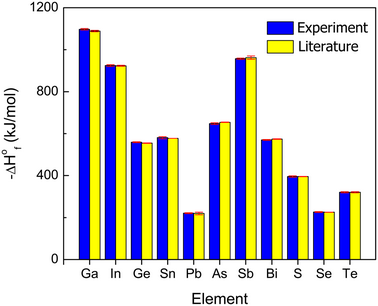Crossref Citations
This article has been cited by the following publications. This list is generated based on data provided by
Crossref.
Subramani, Tamilarasan
Lilova, Kristina
Abramchuk, Mykola
Leinenweber, Kurt D.
and
Navrotsky, Alexandra
2020.
Greigite (Fe
3
S
4
) is thermodynamically stable: Implications for its terrestrial and planetary occurrence
.
Proceedings of the National Academy of Sciences,
Vol. 117,
Issue. 46,
p.
28645.
Majzlan, Juraj
Kiefer, Stefan
Lilova, Kristina
Subramani, Tamilarasan
Navrotsky, Alexandra
Tuhý, Marek
Vymazalová, Anna
Chareev, Dmitriy A.
Dachs, Edgar
and
Benisek, Artur
2022.
Calorimetric study of skutterudite (CoAs2.92) and heazlewoodite (Ni3S2).
American Mineralogist,
Vol. 107,
Issue. 12,
p.
2219.
Majzlan, Juraj
Notz, Stefanie
Haase, Patrick
Kamitsos, Efstratios I.
Tagiara, Nagia S.
and
Dachs, Edgar
2022.
Thermodynamic properties of tellurite (β-TeO2), paratellurite (α-TeO2), TeO2 glass, and Te(IV) phases with stoichiometry M2Te3O8, MTe6O13, MTe2O5 (M2+ = Co, Cu, Mg, Mn, Ni, Zn).
Geochemistry,
Vol. 82,
Issue. 4,
p.
125915.
Drey, Devon
O'Quinn, Eric
Finkeldei, Sarah
Neuefeind, Joerg
and
Lang, Maik
2022.
Local ordering in disordered Nd Zr1-O2-0.5 pyrochlore as observed using neutron total scattering.
Acta Materialia,
Vol. 225,
Issue. ,
p.
117590.
Mielewczyk-Gryń, Aleksandra
Subramani, Tamilarasan
Jaworski, Daniel
Lilova, Kristina
Skubida, Wojciech
Navrotsky, Alexandra
and
Gazda, Maria
2023.
Water uptake and energetics of the formation of barium zirconate based multicomponent oxides.
Physical Chemistry Chemical Physics,
Vol. 25,
Issue. 13,
p.
9208.
Subramani, Tamilarasan
Lilova, Kristina
Householder, Megan
Yang, Shuhao
Lyons, James
and
Navrotsky, Alexandra
2023.
Surface energetics of wurtzite and sphalerite polymorphs of zinc sulfide and implications for their formation in nature.
Geochimica et Cosmochimica Acta,
Vol. 340,
Issue. ,
p.
99.
Navrotsky, Alexandra
and
Koryttseva, Anastasia
2023.
Acid–Base Properties of Oxides Derived from Oxide Melt Solution Calorimetry.
Molecules,
Vol. 28,
Issue. 12,
p.
4623.
Majzlan, Juraj
Jia, Xiaocen
Lilova, Kristina
Subramani, Tamilarasan
Navrotsky, Alexandra
Dachs, Edgar
and
Benisek, Artur
2024.
Thermodynamic stability of selected ASb2O6 and A2Sb2O7 phases (A = Ca, Ba, Cd, Sr, Zn).
Solid State Sciences,
Vol. 154,
Issue. ,
p.
107615.
Navrotsky, Alexandra
and
Scharrer, Manuel
2025.
Experimental Thermochemistry Through the Years with Application to Chalcogenides.
Annual Review of Earth and Planetary Sciences
,
Vol. 53,
Issue. 1,
p.
53.
Scharrer, Manuel
Bonatti, Laura
Geraci, Tullio
Ushakov, Sergey V.
Majzlan, Juraj
Bustamante, Michael
Kojitani, Hiroshi
Guo, Xiaofeng
Xu, Hongwu
Zhang, Lei
Lilova, Kristina
Hayun, Shmuel
Subramani, Tamilarasan
and
Navrotsky, Alexandra
2025.
The joys and jitters of high‐temperature calorimetry.
Journal of the American Ceramic Society,
Vol. 108,
Issue. 6,
Ness, Stuart C.
Moore, Tucker
Kilczewski, Steve
Behler, Kristopher
Dunstan, Matthew
and
McCormack, Scott J.
2025.
Development of oxide melt solution calorimetry for transition metal diborides.
Calphad,
Vol. 90,
Issue. ,
p.
102867.
Czudec, M. M.
Jaworski, D.
Budnik, J.
Mielewczyk-Gryń, A.
Subramani, T.
Gazda, M.
Navrotsky, A.
and
Miruszewski, T.
2025.
Thermoelectric and electrical properties of triple-conducting multicomponent oxides based on substituted barium cerate-zirconate.
Dalton Transactions,
Vol. 54,
Issue. 5,
p.
1994.
Matyushov, I.D.
Aberra, B.G.
Agbanga, G.A.
Leinbach, L.J.
Leinenweber, K.D.
Brugman, B.L.
Ushakov, S.V.
Hong, Q.-J.
and
Navrotsky, A.
2025.
Energetics of high pressure monoclinic Y2O3 and Er2O3 from experiment and computation.
Acta Materialia,
Vol. 289,
Issue. ,
p.
120910.



